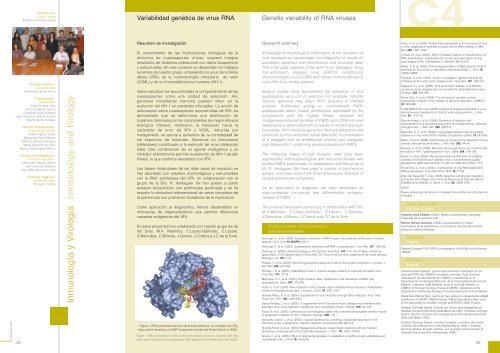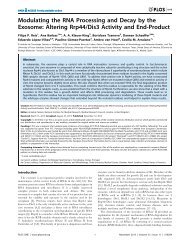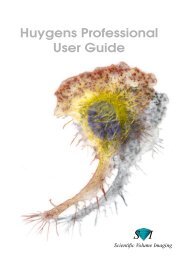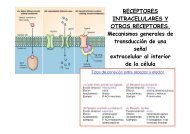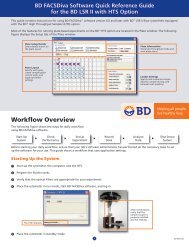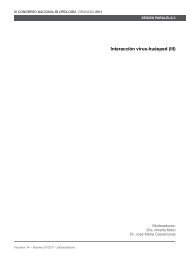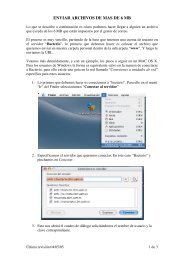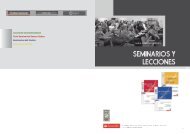Drosophila - Severo Ochoa - Universidad Autónoma de Madrid
Drosophila - Severo Ochoa - Universidad Autónoma de Madrid
Drosophila - Severo Ochoa - Universidad Autónoma de Madrid
You also want an ePaper? Increase the reach of your titles
YUMPU automatically turns print PDFs into web optimized ePapers that Google loves.
Jefe <strong>de</strong> Línea /<br />
Group Lea<strong>de</strong>r:<br />
Esteban Domingo Solans<br />
Variabilidad genética <strong>de</strong> virus RNA<br />
Genetic variability of RNA viruses<br />
C4<br />
CBM 2005/2006<br />
62<br />
Personal Científico /<br />
Scientific Staff:<br />
Cristina Escarmís Homs<br />
Postdoctorales /<br />
Postdoctoral:<br />
Celia Perales Viejo<br />
Verónica Martín García<br />
Armando Arias Esteban<br />
Juan Francisco García Arriaza<br />
Noemí Sevilla Hidalgo<br />
Becarios Predoctorales /<br />
Predoctoral Fellows:<br />
Rubén Agudo Torres<br />
Macarena Sierra García<br />
Mónica Herrera Quintana<br />
Marta Sanz-Ramos Rojo<br />
Samuel Ojosnegros Martos<br />
Técnicos <strong>de</strong> Investigación /<br />
Technical Assistance:<br />
Merce<strong>de</strong>s Dávila Cerrato<br />
Gema Gómez Maríano<br />
Ana Isabel <strong>de</strong> Ávila Lucas<br />
Científicos Visitantes /<br />
Visiting Scientist:<br />
Dr. Juan Cristina<br />
Inmunología y Virología Immunology and Virology<br />
Resumen <strong>de</strong> investigación<br />
El conocimiento <strong>de</strong> las implicaciones biológicas <strong>de</strong> la<br />
dinámica <strong>de</strong> cuasiespecies víricas, requiere integrar<br />
resultados <strong>de</strong> dinámica poblacional con datos bioquímicos<br />
y estructurales. En este contexto se <strong>de</strong>sarrollan los trabajos<br />
recientes <strong>de</strong> nuestro grupo, empleando los virus <strong>de</strong> la fiebre<br />
aftosa (VFA), <strong>de</strong> la coriomeningitis linfocitaria <strong>de</strong> ratón<br />
(VCML) y <strong>de</strong> la inmuno<strong>de</strong>ficiencia humana (VIH-1).<br />
Varios estudios han documentado el comportamiento <strong>de</strong> las<br />
cuasiespecies como una unidad <strong>de</strong> selección. Así,<br />
genomas minoritarios memoria pue<strong>de</strong>n influir en la<br />
evolución <strong>de</strong>l VIH-1 en pacientes infectados. La acción <strong>de</strong><br />
anticuerpos sobre cuasiespecies reconstruidas <strong>de</strong> VFA, ha<br />
<strong>de</strong>mostrado que se selecciona una distribución <strong>de</strong><br />
mutantes dominada por los componentes <strong>de</strong> mayor eficacia<br />
biológica (fitness). Asímismo, la transición hacia la<br />
catástrofe <strong>de</strong> error <strong>de</strong> VFA y VCML, inducida por<br />
mutagénesis, se asocia a aumentos <strong>de</strong> la complejidad <strong>de</strong><br />
los espectros <strong>de</strong> mutantes. Genomas no infecciosos<br />
(<strong>de</strong>fectores) contribuyen a la extinción <strong>de</strong> virus (<strong>de</strong>fección<br />
letal). Una combinación <strong>de</strong> un agente mutagénico y un<br />
inhibidor antirretroviral permite la extinción <strong>de</strong> VIH-1 <strong>de</strong> alto<br />
fitness, lo que confirma resultados con VFA.<br />
Las bases moleculares <strong>de</strong> las altas tasas <strong>de</strong> mutación se<br />
han abordado con estudios enzimológicos y estructurales<br />
con la RNA polimerasa <strong>de</strong>l VFA, en colaboración con el<br />
grupo <strong>de</strong> la Dra. N. Verdaguer. Se han puesto a punto<br />
ensayos bioquímicos con polimerasa purificada y se ha<br />
resuelto la estructura tridimensional <strong>de</strong> varios complejos <strong>de</strong><br />
la polimerasa con polímeros iniciadores <strong>de</strong> la replicación.<br />
Como aplicación al diagnóstico, hemos <strong>de</strong>sarrollado un<br />
microarray <strong>de</strong> oligonucleótidos que permite diferenciar<br />
variantes antigénicos <strong>de</strong>l VFA.<br />
En estos proyectos han colaborado con nuestro grupo los <strong>de</strong><br />
los Dres. M.A. Martínez, C.López-Galín<strong>de</strong>z, E.Lázaro,<br />
S.Manrubia , C.Briones, J.Gomez, J.Cristina y J.C.<strong>de</strong> la Torre.<br />
Figura 1. RNA polimerasa <strong>de</strong>l virus <strong>de</strong> la fiebre aftosa en un complejo con VPg<br />
(rojo), poli A (amarillo) y el UMP incorporado (ver<strong>de</strong>) (<strong>de</strong> Ferrer-Orta et al. 2006).<br />
Figure 1. RNA polymerase of foot-and-mouth disease virus in a complex with VPg<br />
(red), poly A (yellow) and incorporated UMP (green) (from Ferrer-Orta et al. 2006).<br />
Research summary<br />
Knowledge of the biological implications of the dynamics of<br />
viral quasispecies necessitates the integration of results on<br />
population dynamics with biochemical and structural data.<br />
This is the basic premise of the work in our laboratory, using<br />
foot-and-mouth disease virus (FMDV), lymphocytic<br />
choriomeningitis virus (LCMV) and human immuno<strong>de</strong>ficiency<br />
virus (HIV-1) as mo<strong>de</strong>l systems.<br />
Several studies have documented the behaviour of viral<br />
quasispecies as a unit of selection. For example, minority,<br />
memory genomes may affect HIV-1 evolution in infected<br />
patients. Antibodies acting on reconstituted FMDV<br />
quasispecies select mutant distributions dominated by the<br />
components with the highest fitness. Likewise, the<br />
mutagenesis-induced transition of FMDV and LCMV into error<br />
catastrophe is associated with increases of mutant spectrum<br />
complexity. Non-infectious genomes (termed <strong>de</strong>fectors) may<br />
contribute to virus extinction (lethal <strong>de</strong>fection). A combination<br />
of a mutagen and an antiretroviral inhibitor can extinguish<br />
high fitness HIV-1, confirming previous results with FMDV.<br />
The molecular bases of high mutation rates have been<br />
approached with enzymological and structural studies with<br />
purified FMDV polymerase, in collaboration with the group of<br />
Dr. N. Verdaguer. We have used a number of biochemical<br />
assays, and have solved the three-dimensional structure of<br />
several polymerase complexes.<br />
As an application to diagnosis, we have <strong>de</strong>veloped an<br />
oligonucleoti<strong>de</strong> microarray that differentiates antigenic<br />
variants of FMDV.<br />
The projects have been carried out in collaboration with Drs.<br />
M.A.Martínez, C.López-Galín<strong>de</strong>z, E.Lázaro, C.Briones,<br />
S.Manrubia, J.Gómez, J.Cristina and J.C.<strong>de</strong> la Torre.<br />
Publicaciones seleccionadas<br />
Selected publications<br />
Domingo, E., et al. (2005). Population dynamics of RNA viruses: the essential contribution of mutant<br />
spectra. Arch. Virol. 19 [SUPP.], 59-71.<br />
Domingo, E. et al. (2005). Quasispecies dynamics and RNA virus extinction. Virus Res. 107, 129-139.<br />
Domingo, E. (2005). Antiviral strategy on the horizon. Virus Res. 107, 115-116. (Preface written as<br />
guest editor of the Special Issue of Virus Res. On “Virus entry into error catastrophe as a new antiviral<br />
strategy”, vol. 107 nº 2).<br />
Perales, C. et al. (2005). Monitoring sequence space as a test for the target of selection in viruses. J.<br />
Mol. Biol. 345, 451-459.<br />
Novella, I. et al. (2005). Adaptability costs in immune escape variatns of vesicular stomatitis virus.<br />
Virus Res. 107, 27-34<br />
Manrubia, S. C. et al. (2005). High mutation rates, bottlenecks, and robustness of RNA viral<br />
quasispecies. Gene. 347, 273-282.<br />
Yuste, E. et al. (2005). Few mutations in the 5´lea<strong>de</strong>r region mediate fitness recovery of <strong>de</strong>bilitated<br />
human immuno<strong>de</strong>ficiency type 1 viruses. J.Virol. 79, 5421-5427.<br />
Gran<strong>de</strong>-Pérez, A. et al. (2005). Suppression of viral infectivity through lethal <strong>de</strong>fection. Proc. Natl.<br />
Acad. Sci. USA. 102, 4448-4452.<br />
García-Arriaza, J. et al. (2005). A segmented form of foot-and-mouth disease virus interferes with<br />
standard virus: a link between interference and competitive fitness. Virology. 335 155-164.<br />
Tapia, N. et al. (2005). Combination of a mutagenic agent with a reverse transcriptase inhibitor results<br />
in systematic inhibition of HIV-1 infection. Virology 338, 1-8.<br />
González-López, C. et al. (2005). Invariant aphthovirus consensus nucleoti<strong>de</strong> sequence in the<br />
transition to error catastrophe. Infection Genetics and Evolution 5, 366-374.<br />
Gran<strong>de</strong>-Pérez, A. et al. (2005). Mutagenesis-induced, large fitness variations with an invariant<br />
arenavirus consensus genomic nucleoti<strong>de</strong> sequence. J. Virol. 79, 10451-10459.<br />
Greene, I. et al. (2005). Effect of alternating passage on adaptation of sindbis virus to vertebrate and<br />
invertebrate cells. J. Virol. 79, 14253-60.<br />
Arias, A. et al. (2005). Mutant viral polymerase in the transition of virus<br />
to error catastrophe i<strong>de</strong>ntifies a critical site for RNA binding. J. Mol.<br />
Biol. 353, 1021-1032.<br />
Arribas, M. et al. (2005). Effect of metallic cations on the efficiency of<br />
DNA amplification. Implications for nucleic acid replication during<br />
early stages of life. International J. Astrobiol. 4,115-123.<br />
Möller, P. et al. (2005). Homo-oligomerization of Marburgvirus VP35 is<br />
essential for its function in replication and transcription. J. Virol. 79,<br />
14876-14886.<br />
Pariente, N. et al. (2005). Action of mutagenic agents and antiviral<br />
inhibitors on foot-and-mouth disease virus. Virus Res. 107, 183-193.<br />
Salguero, F.J. et al. (2005). Foot-and-mouth disease virus (FMDV)<br />
causes an acute disease that can be lethal for adult laboratory mice.<br />
Virology. 332, 384-396.<br />
Ferrer-Orta, C. et al. (2006). The structure of a protein primerpolymerase<br />
complex in the initiation of genome replication. EMBO J.<br />
25, 880-888.<br />
Costa-Mattioli, M. et al. (2006) Analysis of sequential hepatitis A virus<br />
strains reveals coexistence of distinct viral subpopulations. J. Gen.<br />
Virol. 87, 115-118.<br />
García-Arriaza J. et al. (2006). Dynamics of mutation and<br />
recombination in a replicating population of complementing, <strong>de</strong>fective<br />
viral genomes. J Mol. Biol. 360, 558-572.<br />
Manrubia, S. C. et al. (2006). Long-range transport and universality<br />
classes in in vitro viral infection spread. Europhysics Letters. 74, 547-553.<br />
Martín, V. et al. (2006). Viral fitness can influence the repertoire of virus<br />
variants selected by antibodies. J. Mol. Biol. 362, 44-54.<br />
Briones, C. et al. (2006). Monority memory genomes can influence the<br />
evolution of HIV-1 quasiespecies in vivo. Gene. 384, 129-138.<br />
Martín, V. et al. (2006). Microarray-based i<strong>de</strong>ntification of antigenic<br />
variants of foot-and-mouth disease virus: a bioinformatics quality<br />
assessment. BMC Genomics 7: 117 doi:10.1186/1471-2164-7-117.<br />
Ferrer-Orta, C. et al. (2006). A comparison of viral RNA-<strong>de</strong>pen<strong>de</strong>nt<br />
RNA polymerases. Curr. Opin Struct Biol. 16, 27-34.<br />
Díaz-San Segundo F. et al. (2006). Selective Lymphocyte Depletion<br />
during the Early Stage of the Immune Response to Foot-and-Mouth<br />
Disease Virus Infection in Swine. J. Virol. 80, 2369–2379.<br />
Libros:<br />
Nueve referencias <strong>de</strong> libros no incluidas/ Nine references of books not<br />
inclu<strong>de</strong>d.<br />
Tesis doctorales<br />
Doctoral Theses<br />
Armando Arias Esteban. (2005). Bases poblacionales y abordaje<br />
molecular <strong>de</strong> la variación viral.<br />
Mónica Herrera Quintana. (2006). Caracterización y bases<br />
moleculares <strong>de</strong> la persistencia y la virulencia <strong>de</strong>l virus <strong>de</strong> la fiebre<br />
aftosa en cultivos celulares.<br />
Patentes<br />
Patents<br />
Patente Europea P1457 EPPC concedida el 14-9-2006 con el Número<br />
128429.<br />
Premios<br />
Awards<br />
Armando Arias Esteban, premio para Personal Investigador no en<br />
plantilla (PINP) <strong>de</strong>l CBMSO concedido a la mejor Tesis Doctoral<br />
realizada en los laboratorios <strong>de</strong>l CBMSO y presentada en el<br />
Departamento <strong>de</strong> Biología Molecular <strong>de</strong> la <strong>Universidad</strong> Autónoma <strong>de</strong><br />
<strong>Madrid</strong>. / Armando Arias Esteban, prize to non-staff member of<br />
CBMSO to the best Doctoral Thesis at CBMSO, presented at the<br />
Department of Molecular Biology of <strong>Universidad</strong> Autónoma <strong>de</strong> <strong>Madrid</strong>.<br />
Marta Sanz-Ramos Rojo, premio al mejor póster en categoría <strong>de</strong> calidad<br />
científica en EUROPIC 2006 Finlandia. / Marta Sanz-Ramos Rojo, prize<br />
to the best poster for scientific content at EUROPIC 2006, Finland.<br />
Esteban Domingo Solans, Director <strong>de</strong>l Centro <strong>de</strong> Investigación en<br />
Sanidad Animal (CISA-INIA) hasta Marzo <strong>de</strong> 2005. / Esteban Domingo<br />
Solans, Director of Centro <strong>de</strong> Investigación en Sanidad Animal (CISA-<br />
INIA) until March, 2005.<br />
Esteban Domingo Solans, miembro fundador y miembro <strong>de</strong>l comité<br />
científico <strong>de</strong>l Instituto Para Limes (Países Bajos, 2006). / Esteban<br />
Domingo Solans, foun<strong>de</strong>r member, and scientific board member of<br />
Institute Para Limes (The Netherlands, 2006).<br />
63


